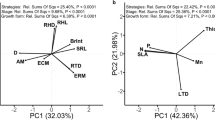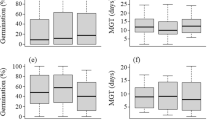Abstract
Shoot regeneration after prescribed burning or following the freezing temperatures of winter was monitored for nineteen heathland species present in an Arctostaphyleto-Callunetum community in northeast Scotland. Species whose renewal buds were near the surface of the ground started to grow earlier in the spring than species with renewal buds above the surface, but grouping species according to the position of their renewal bud (i.e. their life-form) did not account for all of the interspecific variation apparent. In the case of shoot regeneration after fire, species whose renewal buds were destroyed by fire because they were above-ground started to regenerate about the same time as species with belowground buds, protected from fire, but reached their maximum frequency of occurrence later. Grouping species by life-form was of limited value as a means of interpreting this interspecific variation in the timing of shoot regeneration after fire. It would be unwise to use plant life-form as the sole basis for interpreting or predicting a species' response to temperature stress when extreme temperatures occur regularly, as they do in heathland. The possible use of other plant traits to interpret and predict interspecific variation in the regeneration rate of heathland plants is discussed.
Similar content being viewed by others
References
Adamson, R., 1935. The plant communities of Table mountain. III. A six years' study of regeneration after burning. J. Ecol. 23: 44–55.
Al-Mufti, M. M., Sydes, C. L., Furness, S. B., Grime, J. P. & Band, S. R., 1977. A quantitative analysis of shoot phenology and dominance in herbaceous vegetation. J. Ecol. 65: 759–791.
Birse, E. L., 1971. Assessment of climatic conditions in Scotland. 3. The bioclimatic sub-regions. MacCauley Institute for Soil Research, Aberdeen, Scotland. 12 pp.
Chapman, R. R. & Crow, G. E., 1981. Application of Raunkiaer's life-form system to plant species survival after fire. Bull. Torrey Bot. Club 108: 472–478.
Forgeard, F. & Touffet, J., 1980. La recolonisation des landes et des pelouses dans la région de Paimpont. Évaluation de la végétation au cours des trois années suivant l'incendie. Bull. Écol. 11: 349–358.
Gimingham, C. H., 1972. Ecology of Heathlands. Chapman & Hall, London. 266 pp.
Hobbs, R. J., 1981. Post-fire succession in heathland communities. Unpubl. Thesis, University of Aberdeen, Scotland. 371 pp.
Mallik, A. U., 1982. Post-fire micro-habitat and plant regeneration in heathland. Unpubl. Thesis, University of Aberdeen, Scotland. 127 pp.
Mallik, A. U. & Gimingham, C. H., 1983. Regeneration of heathland plants following burning. Vegetatio 53: 45–58.
Marren, P., 1977. Muir of Dinnet: Portrait of a National Nature Reserve. Nature Conservancy Council, Aberdeen, Scotland. 120 pp.
McVean, D. N. & Ratcliffe, D. A., 1962. Plant Communities of the Scottish Highlands. Nature Conservancy Monographs 1. HMSO, U.K. 445 pp.
Noble, I. R. & Slatyer, R. O., 1980. The use of vital attributes to predict successional changes in plant communities subject to recurrent disturbances. Vegetatio 43: 5–21.
Raunkiaer, C., 1934. The Life Form of Plants and Statistical Plant Geography. Clarendon Press, Oxford. 632 pp.
Tutin, T. G., Heywood, V. H., Burges, N. A., Valentine, D. H., Walters, S. M. & Webb, D. A., 1964–1980. Flora Europaea, Vols. I–V. Cambridge University Press, London.
Ward, S. D., 1970. The phytosociology of Calluna—Arctostaphylos heaths in Scotland and Scandinavia. I. Dinnet Moor, Aberdeenshire. J. Ecol. 58: 847–863.
Author information
Authors and Affiliations
Additional information
Nomenclature follows Tutin et al. (1964–1980) for vascular plants.
Acknowledgements. The Nature Conservancy Council and Mr J. J. Humphries kindly allowed Dinnet Moor to be used for the work presented here. One of us (RJR) received financial support for field work from the Natural Sciences and Engineering Research Council of Canada.
Rights and permissions
About this article
Cite this article
Reader, R.J., Mallik, A.U., Hobbs, R.J. et al. Shoot regeneration after fire or freezing temperatures and its relation to plant life-form for some heathland species. Vegetatio 55, 181–189 (1984). https://doi.org/10.1007/BF00045021
Accepted:
Issue Date:
DOI: https://doi.org/10.1007/BF00045021




